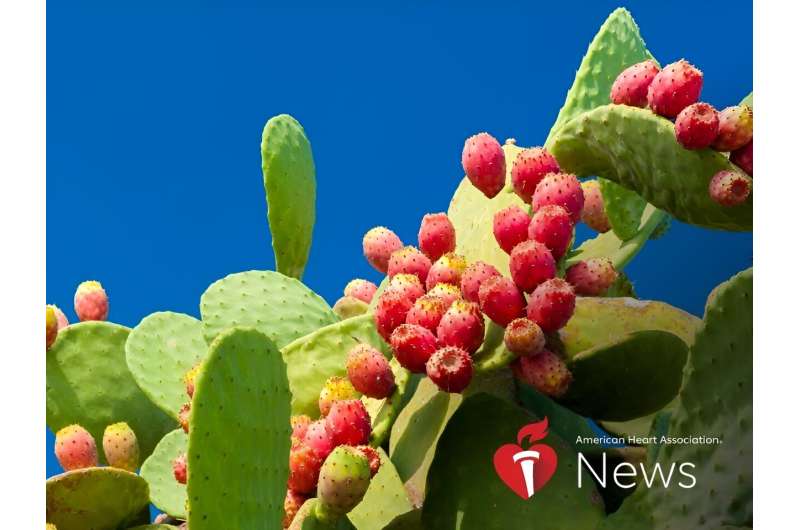This article has been reviewed according to Science X's editorial process and policies. Editors have highlighted the following attributes while ensuring the content's credibility:
fact-checked
reputable news agency
proofread
Get past its spines and reap health benefits from the prickly pear cactus

Covered in menacing needlelike spines, the prickly pear cactus demands to be treated with care. In return, it will reward you with a juicy neon fruit and fleshy green pads that have nourished people for millennia.
While the spines that protect the plant from predators can intimidate, the showy clusters of yellow, red and orange flowers that bloom atop the cactus pads can captivate. These ephemeral flowers give way to the oval fruit that, like the pads, packs a nutritional punch including vitamin C, minerals and fiber.
"Prickly pears are considered to have many health benefits," said Hope Wilson, a dietitian and nutritionist with the University of Arizona Cooperative Extension. "They're low in sodium, low in fat and have zero cholesterol"—all of which can contribute to heart disease.
The prickly pear cactus—part of the Opuntia genus– has been prized as food and medicine by Indigenous people in the Southwestern U.S. and Latin America. It's commonly known in Spanish as nopal or cacto. North of the border, Texas adopted the cactus as it official state plant in 1995, and Arizona, New Mexico and California have showcased its attributes in festivals.
Although the drought-tolerant plant is native to the Americas, particularly in desert areas, different varieties grow throughout the world, including Australia. "I got a phone call from someone doing a documentary in Kenya and they said, 'We found a prickly pear,'" Wilson said.
She touts the benefits of the prickly pear through her outreach work on food safety and nutrition in central Arizona. While talking about preparing different foods, she has observed that more people seem to be familiar with the fruit—tuna in Spanish—than the edible pads, she said.
Wilson compared the taste of the fruit to that of watermelon. It's often turned into jams, jellies and even cocktails. The fruit's hairlike prickles, called glochids, should be peeled and the flesh scooped out. "But it's not as common for people, especially those who are coming from outside the desert," to consider eating the pads.
She's doing her part to bring attention to the culinary attributes and health benefits of the fruit and the highly hydrating cactus pads.
While it grows abundantly in the wild, the cactus plant can be cultivated. "Look for the tender ones," she said of the pads. "The spring is probably a good time for harvesting nopales to find the new and younger pads."
Once the pads are harvested, remove the spines before cooking. Grill the pads whole or diced, then sauté them with onions and other vegetables. Wilson likened the taste to a cross between okra and green beans.
If wrestling with spines doesn't appeal to you, Wilson suggests checking grocery stores for ready-to-eat tunas and nopales—fresh or canned—but check labels for added sugars or high levels of sodium.
The prickly pear is popular in jelly form, she said, but use it sparingly on desserts, snacks or sandwiches because of the fruit's high sugar content, which helps with preservation and its gel-like texture. "If making prickly pear juice at home, remember to dilute the juice with water because drinking a lot of prickly pear juice all at once can cause stomach discomfort and possible nausea," she said.
And if you're ready to meet the prickly pear head-on, equip yourself with a good pair of tongs. It may be the best way to avoid a prickly encounter—just ask Wilson.
She once tried to get a close-up picture of a colorful tuna and promptly felt the defensive sting of the prickly pear in her bare hand. "Just be safe and wear heavy gloves," she said.
Copyright © 2023 HealthDay. All rights reserved.





















